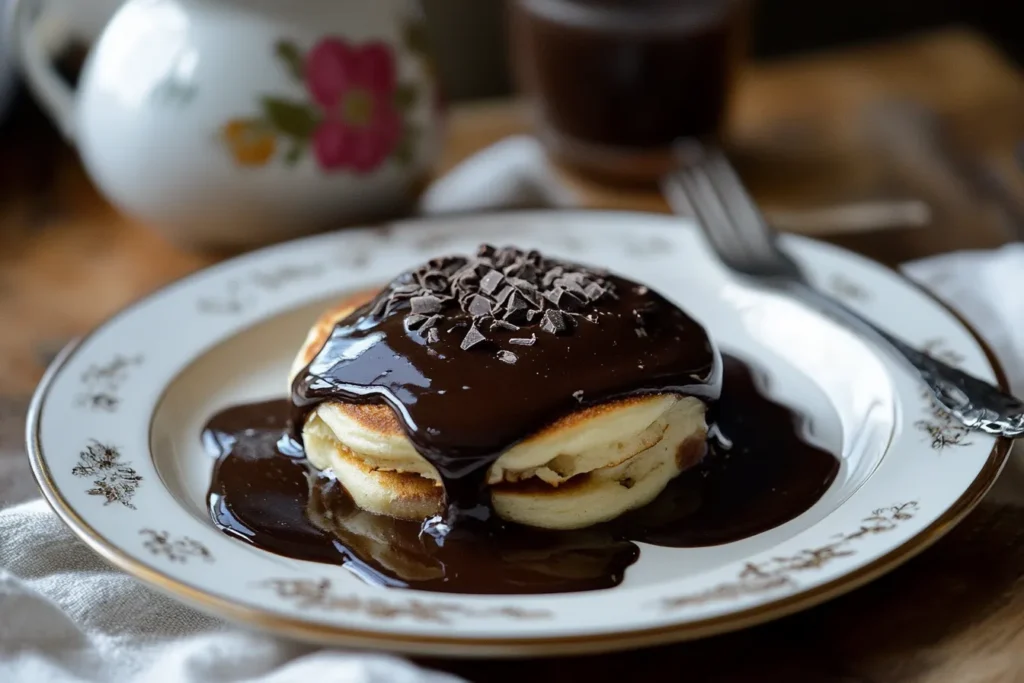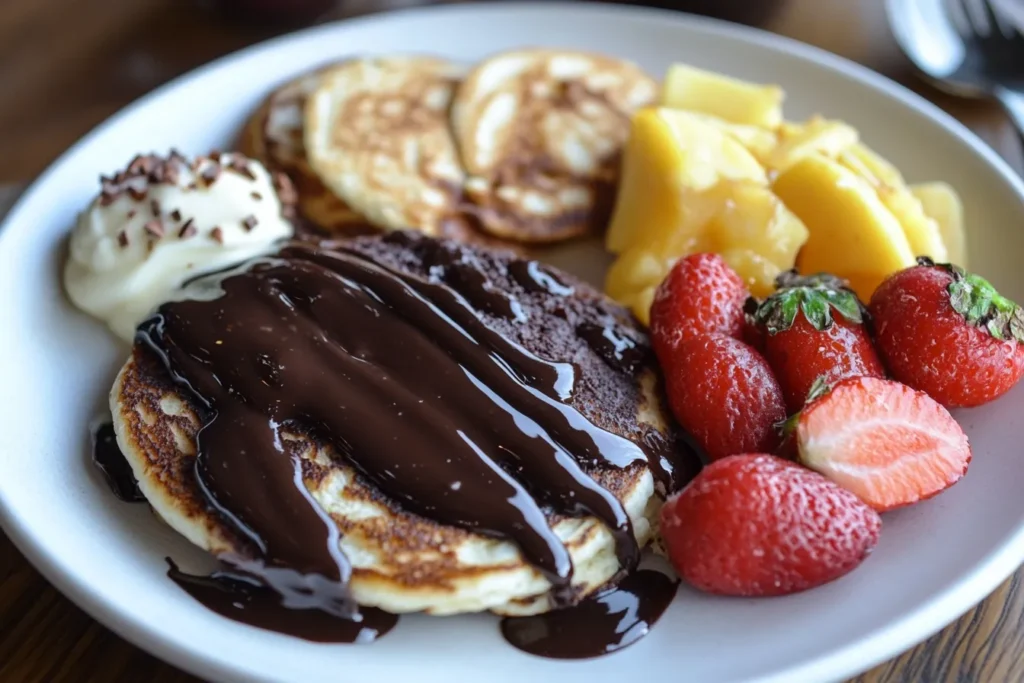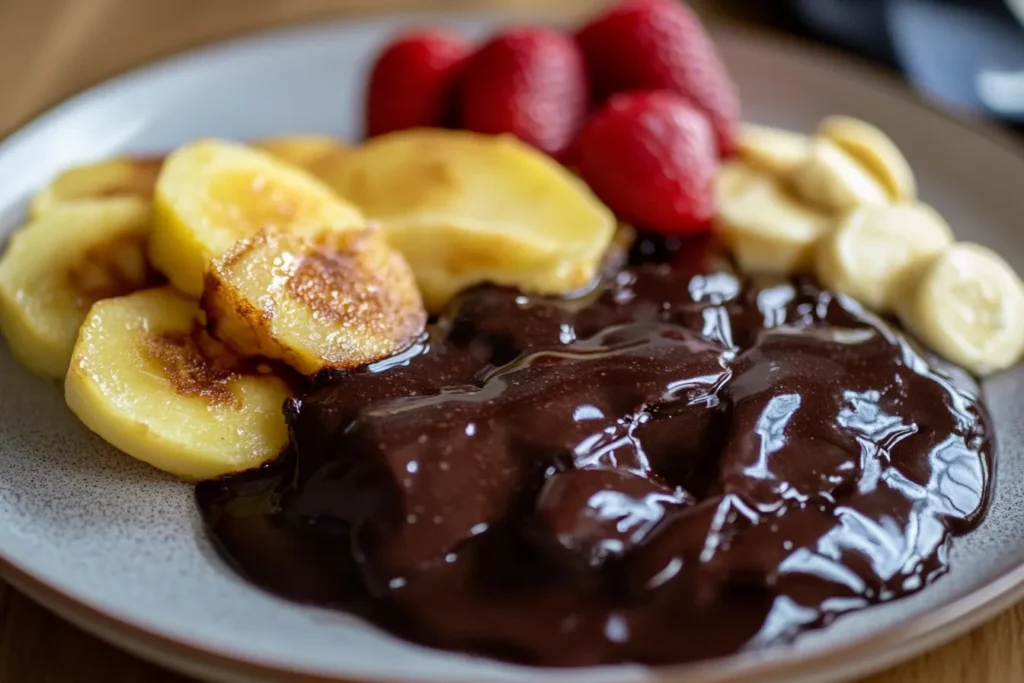Have you ever seen a stack of mini pancakes and thought, “How do I make those adorable little bites at home?” Whether you’re planning a fun breakfast for your family, prepping a brunch spread for friends, or just looking to try something new, mini pancakes are the perfect solution. They’re quick, easy, and a great way to switch up your pancake routine. Plus, their tiny size makes them irresistibly cute and perfect for dipping, stacking, or even turning into pancake cereal! If you’re like me and love recipes that are both fun to make and delicious to eat, you’re going to love this step-by-step guide. Let’s get cooking!
List Of Contents
What Is Chocolate Gravy?
Origins of Chocolate Gravy
Chocolate gravy, a beloved Southern treat, originated in the rural regions of Appalachia. Often served with fluffy biscuits, this sweet treat combines chocolate, milk, and flour into a silky sauce. It’s believed to have evolved as an affordable dessert option when traditional chocolate desserts were out of reach. Check out more recipes here.
Common Uses of Chocolate Gravy in Dishes
This versatile sauce isn’t just for biscuits. Chocolate gravy is a favorite topping for pancakes, waffles, and even drizzled over ice cream. Its smooth texture and rich flavor make it a staple at breakfasts and special occasions alike. Check out more recipes here.
How Chocolate Gravy Works: The Science of Thickening
Perfect chocolate gravy relies on understanding the role of its key ingredients and cooking techniques. When the mixture doesn’t thicken, it’s usually due to an imbalance or misstep in this process.
The Role of Starch in Thickening
Starch, whether from flour or cornstarch, is the backbone of chocolate gravy’s consistency. When heated with liquid, starch molecules absorb water and swell, creating a thick, glossy texture. Without enough starch, the mixture will remain watery. Check out more recipes here.
Importance of Proper Heat Application
Heat activates the thickening agents in chocolate gravy. However, applying too little heat means the starch won’t gelatinize, while overheating can break the bonds, making the sauce thin again. Check out more recipes here.
How Ingredients Interact to Achieve Thickness

Every ingredient in chocolate gravy plays a role in its texture:
- Milk: Provides the liquid base and contributes to creaminess.
- Sugar: Enhances sweetness but can thin out the gravy if used excessively.
- Butter: Adds richness and smoothness.
- Cocoa Powder or Chocolate: The star flavor that needs to be balanced with the other ingredients.
Understanding these interactions is crucial for troubleshooting problems and achieving the perfect consistency. Check out more recipes here.
Essential Ingredients for Chocolate Gravy
To master chocolate gravy, focus on the quality and role of its key ingredients.
Flour or Cornstarch as Thickening Agents
The choice between flour and cornstarch affects the gravy’s texture:
- Flour: Creates a slightly opaque, hearty consistency. It’s forgiving but requires longer cooking to eliminate the raw taste.
- Cornstarch: Produces a clear, silky texture but needs precise measurement and careful cooking to avoid lumps.
The Role of Milk, Butter, and Sugar in Consistency
- Milk: Controls the fluidity of the gravy. Whole milk is ideal for its fat content, but other options like almond or oat milk can work with adjustments.
- Butter: Not only enhances flavor but also binds the ingredients, ensuring a smooth finish.
- Sugar: Sweetens the gravy but must be balanced to avoid thinning the sauce.
By selecting the right proportions and quality ingredients, you’ll create a base that thickens consistently.
Common Reasons Chocolate Gravy Fails to Thicken
When your chocolate gravy remains runny, it’s a clear signal that something has gone wrong in the preparation. Understanding the most frequent culprits is essential to identifying where your recipe may have gone astray.
Insufficient Thickening Agent (Flour or Cornstarch)
One of the most common reasons for chocolate gravy not thickening is the lack of sufficient starch. Thickening agents like flour or cornstarch are essential to achieving the desired consistency. Without enough of these, your mixture will never reach the proper thickness.
- Flour: If under-measured, it won’t provide enough structure. Using a kitchen scale ensures accuracy.
- Cornstarch: Requires precise measuring, as too little won’t activate the gelatinization process necessary for thickening.
Tip: Always use the exact proportions specified in the recipe and mix the starch thoroughly with other dry ingredients before adding liquids.
Incorrect Measurements of Key Ingredients
Even slight deviations in ingredient measurements can upset the balance:
- Too much milk can dilute the mixture.
- Excess sugar can interfere with the thickening process by drawing water out of the starch.
Ensure you double-check all measurements, especially if you’re scaling the recipe up or down.
Substituting Ingredients Without Adjusting Ratios

Substitutions can be tricky when making chocolate gravy. For example:
- Swapping whole milk for a low-fat alternative will reduce the fat content, making the gravy thinner.
- Using alternative thickeners like tapioca or arrowroot starch requires adjusted ratios since they differ in strength.
If substitutions are necessary, research how the replacement behaves in terms of thickening.
Cooking Technique Problems
Even with perfect ingredients, improper techniques can sabotage your chocolate gravy.
Using the Wrong Heat Temperature
Temperature is crucial to activate the thickening properties of starch. The ideal approach involves:
- Gradually increasing the heat to medium, allowing the starch to activate.
- Avoiding high heat, which can cause scorching or break the bonds of the thickened mixture.
If you cook on low heat for too long, the starch may never fully activate, leaving you with a runny consistency.
Not Stirring Constantly During Cooking
Starch tends to settle at the bottom of the pan, where it can clump or burn if not stirred. Continuous whisking:
- Ensures even distribution of heat.
- Prevents lumps from forming.
- Helps you monitor the texture as it thickens.
A good-quality silicone whisk or spoon can make this process easier.
Adding Ingredients Out of Order
The order in which you combine ingredients matters. For example:
- Adding milk too quickly to dry ingredients can create lumps.
- Adding sugar before the starch has thickened can hinder the process.
To avoid this, always follow the recipe sequence carefully, mixing dry ingredients first and incorporating wet ingredients gradually.
Equipment Concerns
Using Non-Stick or Low-Quality Cookware
While non-stick pans are convenient, they may distribute heat unevenly. A heavy-bottomed saucepan or stainless-steel pan ensures even heating, which is critical for smooth, thick chocolate gravy. Low-quality cookware may also react with acidic ingredients like cocoa powder, altering the texture.
The Impact of Overheating on Thickness
Overheating can undo all your hard work. When the mixture gets too hot:
- The starch bonds break, causing the gravy to thin.
- Chocolate or cocoa powder may scorch, creating a gritty texture.
Using a kitchen thermometer to monitor the temperature can help prevent overheating.
How to Fix Runny Chocolate Gravy: Quick Solutions
When your chocolate gravy won’t thicken, don’t worry—it’s not the end of your dish! With a few simple adjustments, you can rescue your gravy and even prevent future mishaps. This section focuses on quick fixes, prevention strategies, and pro tips for achieving that silky, thick texture every time.
Immediate Fixes

If your chocolate gravy is already on the stove and won’t thicken, try these quick solutions to save it:
Adding More Thickening Agent Mid-Cooking
If the gravy is runny, the quickest fix is to add more starch:
- Make a Slurry: Combine 1 tablespoon of cornstarch or flour with 2 tablespoons of cold milk or water. Stir until smooth.
- Incorporate Slowly: Gradually whisk the slurry into the hot gravy. Continue cooking and stirring until the desired thickness is achieved.
Pro Tip: Avoid adding dry starch directly to the hot gravy—it will clump and create a gritty texture.
Adjusting Heat for Better Consistency
If the thickening agent is sufficient but the gravy remains thin, the issue may be heat:
- Raise the Heat: Bring the gravy to a gentle boil. Starch thickens best at higher temperatures, but avoid overheating.
- Cook Longer: Allow the gravy to simmer for 1–2 minutes after it starts bubbling. This gives the starch time to fully activate.
Be patient; rushing this step often leads to uneven textures.
Preventing Future Problems
Consistently thick and smooth chocolate gravy is all about preparation and attention to detail. By addressing common issues before they arise, you can avoid runny results.
Measuring Ingredients Accurately
Accuracy is crucial when working with thickening agents and liquids. Follow these tips for precise measurements:
- Always use proper measuring cups: for dry ingredients and measuring spoons or liquid measuring cups for wet ingredients to ensure accuracy.
- Weigh Ingredients: A kitchen scale is especially useful for flour and cocoa powder, which can compact and vary in volume.
Pro Tip: Keep track of any adjustments you make to your recipe to easily replicate your successes.
Pre-Mixing Dry Ingredients to Avoid Lumps
Mix flour or cornstarch with sugar and cocoa powder first, then gradually incorporate the liquid ingredients. This prevents clumping by evenly dispersing the starch.
- Sift the dry ingredients together for extra smoothness.
- Slowly pour in the milk while whisking continuously to ensure a smooth, lump-free mixture.
By creating a consistent base, you’ll set the stage for perfectly thickened gravy.
Cooking Slowly and Monitoring Consistency
Chocolate gravy thrives on slow, steady cooking. Hurrying through the process can result in either under-thickened or overcooked outcomes.
- Stir constantly to prevent scorching.
- Cook over medium heat to activate the starch molecules without causing them to break down.
Pro Tip: If the gravy thickens too fast, reduce the heat and stir in a splash of milk to achieve the desired consistency.
Pro Tips for Perfect Chocolate Gravy Every Time
Looking to take your chocolate gravy to the next level? These expert tips ensure both great flavor and consistency.
Enhancing Flavor While Maintaining Consistency
Thickening chocolate gravy is important, but ensuring a rich flavor is equally essential. Avoid overloading the gravy with ingredients that could thin it.
- Use high-quality cocoa powder or chocolate for a rich, robust taste.
- Add a pinch of salt to enhance the sweetness and balance flavors.
- Add a teaspoon of vanilla extract once the gravy has thickened to enhance its flavor.
Alternative Thickening Agents for Dietary Needs
If you’re cooking for someone with dietary restrictions, try these substitutions:
- For a gluten-free option, substitute all-purpose flour with arrowroot powder or rice flour.
- For a low-calorie alternative, substitute cornstarch with xanthan gum, using 1/4 teaspoon per cup of liquid.
- For a vegan option, use almond or oat milk instead of regular milk and substitute butter with plant-based alternatives.
Experiment with these substitutes to find the best fit for your recipe.
Testing Gravy Thickness Before Serving
Before serving, check the consistency by running a spoon through the gravy to ensure it’s just right:
- If the gravy coats the back of a spoon and holds its shape, it’s ready to serve.
- If the gravy slides off the spoon too quickly, it’s too thin and needs further thickening. Reheat and add a slurry to adjust.
Pro Tip: Gravy thickens slightly as it cools, so stop cooking when it’s just shy of your desired thickness.
FAQs
- Why does my chocolate gravy taste gritty? Gritty gravy is usually caused by undissolved sugar or poorly combined dry ingredients. Sift and whisk thoroughly to avoid this.
- Can I reheat chocolate gravy? Yes! Reheat gently on low heat, stirring constantly. If the gravy becomes too thick, add a splash of milk to adjust the consistency.
- How do I prevent lumps in my gravy? Pre-mix the dry ingredients, whisk thoroughly, and slowly add the liquid while stirring continuously.
- What’s the best chocolate to use? Using high-quality unsweetened cocoa powder or dark chocolate provides a rich flavor without adding too much sweetness.
- Can I freeze chocolate gravy? While possible, freezing can affect the texture. Thaw and reheat slowly, stirring to restore consistency.
- What milk alternatives work best? Almond and oat milk make great substitutes, though they might subtly change the flavor profile.
- Why is my gravy too thick? Overcooking or adding too much starch can result in an overly thick consistency. Thin it by adding warm milk or water.
- Can I make chocolate gravy without butter? Yes, but butter adds richness. Substitute with a plant-based fat if needed.
- Is chocolate gravy supposed to be sweet? Yes, but sweetness should complement the chocolate flavor. Adjust sugar levels to your taste.
- What dishes pair best with chocolate gravy? Chocolate gravy pairs perfectly with biscuits, pancakes, waffles, or even ice cream for a classic treat. Get creative!
